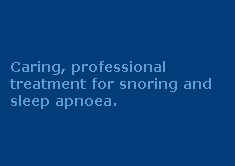Snoring Treatment
Snoring treatments are readily available for most patients -- but the challenge is in finding the right form of treatment.
First of all, it is important to ensure that the condition truly is 'simple snoring'. Simple snoring means the soft tissues of the upper airway flutter as air passes through a constricted area, but there is no actual obstruction of the airflow (which would probably mean a diagnosis of apnoea).
In most cases of simple snoring, the tongue mass is the major cause of the condition. As the sleeper relaxes and their tongue falls back into the airway, the resulting constriction causes the snoring noise.
Treatment for snoring in this situation is simply a matter of repositioning the tongue so that it is kept clear of the airway. This is typically achieved by either a mandibular repositioning device, or a tongue stabilising device.
Mandibular repositioning devices are the more popular form of treatment for snoring becuase they are relatively discreet (sitting hidden inside the patient's mouth, like an orthodontic splint or specialised mouthguard) but they are generally more expensive or potentially harmful to the temporo mandibular joint (TMJ). Being the strongest muscles in the body, if the jaw is misaligned because of a poorly fitted mandibular repositioning device, there is a real risk of serious harm to the TMJ. This can result in serious, painful and long term consequences.
The other common form of treatment for snoring is via a tongue stabilising device. TSDs generally work by holding the tongue in a protruded position clear of the airway. This is usually achieved by using a suction bulb to hold the tongue in a clear position. This treatment for snoring is highly effective, relatively inexpensive and unlikely to cause harm to the TMJ ... but it is not a particularly discreet form of treatment. That is, the suction bulb which holds the tongue forward is visible outside the mouth.
Given that the suction bulb only needs to be inserted when the sufferer is ready to go to sleep, this is usually not a real problem as it can be inserted after 'lights out' and removed first thing next morning.
Regardless of which snoring treatment you consider using, first make sure you are truly suffering only from simple snorning. A diagnostic sleep study is a worthwhile first step in getting treatment for snoring, and will alert you to any more serious conditions which might exist.


